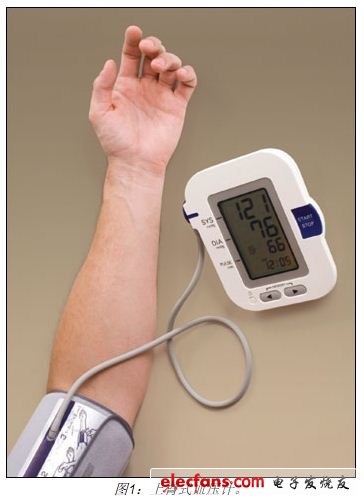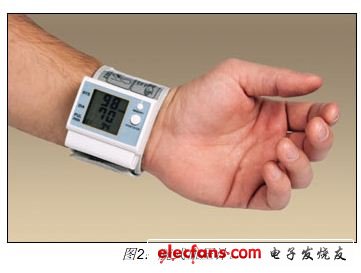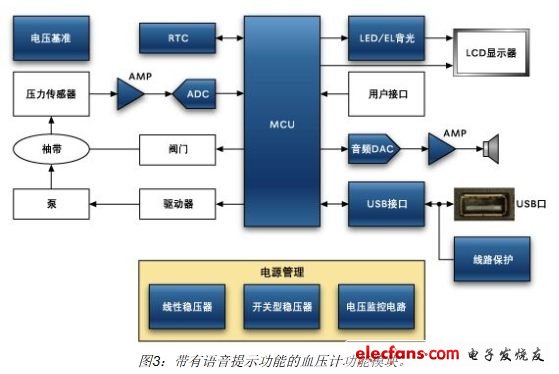With the improvement of people's living standards, medical monitoring equipment has gradually entered the family, and the sphygmomanometer is a common household medical device. The sphygmomanometer mainly uses an inflatable cuff and monitoring equipment to measure blood pressure through listening mode; it can also use a pressure sensor to measure blood pressure. This sphygmomanometer can be achieved in two ways: manually inflate the cuff and monitor the sound of the artery wall with a stethoscope (auscultation method); or embed a pressure sensor inside the sphygmomanometer to measure the vibration of the artery wall (vibration law).
There are two types of automatic blood pressure monitors : upper arm blood pressure monitors and wrist blood pressure monitors. The upper arm sphygmomanometer includes a balloon, which is tied to the upper arm during measurement. The inflatable cuff is connected to a monitor placed near the arm through a hose. The wrist sphygmomanometer has a small size, and the entire device can be wrapped around the wrist. Therefore, the size requirements of such products are strict. Some upper arm sphygmomanometers require manual inflation, but most upper arm and wrist sphygmomanometers currently on the market use a fully automatic design.

Measurement technology: The automatic electronic sphygmomanometer first inflates the cuff so that it has sufficient pressure to prevent blood flow in the local aorta. As the pressure is gradually released, when blood begins to flow through the artery, the measured pressure value is the systolic pressure of the heart. At the same time, the rate of pulse beating can also be monitored. Continue to deflate slowly, so that the pressure in the cuff gradually decreases. When the cuff pressure drops to or slightly lower than the diastolic pressure, the blood flow resumes to be unobstructed. This completes a complete measurement cycle. The entire process is completed by the pump, inflatable cuff, electronic valve and pressure sensor in the device.
The signal generated by the pressure sensor is sent to the ADC after being conditioned by an operational amplifier or an instrumentation amplifier. Then, for different types of sensors and monitors, appropriate methods are used to calculate systolic blood pressure, diastolic blood pressure and pulse rate in the digital domain, and the obtained results are displayed on the LCD screen, usually also the data and the corresponding time / The date is stored in non-volatile memory.

Data interface
Some sphygmomanometers can upload data to a computer for more in-depth analysis and later measurement tracking. Data can be transmitted through the USB interface. You can choose a discrete USB transceiver, or you can choose to build a microcontroller of this transceiver.
Voice prompt: The audio prompt of the sphygmomanometer can be a simple beep or high-end voice prompt. A simple buzzer can be driven by one or two pulse width modulation (PWM) output ports of a microcontroller; for advanced voice prompt function circuits, audio digital-to-analog converters and amplifiers can be selected to process audio signals.
Power management: The upper arm sphygmomanometer is usually powered by 4 AAA alkaline batteries, and most wrist sphygmomanometers are powered by 2 AAA alkaline batteries. The sphygmomanometer pump and analog circuit require 5V or 3.3V power supply, and the digital circuit selects 3.3V or 1.8V power supply according to the specific measurement technology used. Therefore, a typical upper arm sphygmomanometer requires a boost / buck switching power supply to provide 5V power to the pump / analog circuit, and a low dropout linear regulator (LDO) to power the digital circuit. A typical wrist sphygmomanometer uses a boost converter to provide the 3.3V power required by the pump / analog circuit, and uses an LDO to convert the input voltage to 1.8V to power the digital circuit.

In order to extend the battery life, the sphygmomanometer can turn off the power while working, and only maintain the real-time clock (RTC) effective and can quickly restore the working state of the sphygmomanometer.
Display and backlight : Most sphygmomanometers use a simple segment LCD display, which contains 100 segments or less, and the LCD driver is usually integrated inside the microcontroller. Use one or two white LEDs or EL lamps to provide backlight. Wrist sphygmomanometer can use switching power supply topology to provide white LED driver, and upper arm sphygmomanometer can use linear voltage regulator to provide white LED driver.
Microcontroller : The core of the sphygmomanometer's functional circuit is the microcontroller. The MAXQ2010 microcontroller developed by Maxim is a low-power, 16-bit device that includes a high-performance 12-bit multi-channel ADC and LCD interface. With high-performance, low-power mixed-signal integrated circuits, it can be ideally used for sphygmomanometer design. The device has 64KB flash memory, 2KB RAM, three 16-bit timers and two universal synchronous / asynchronous receiver / transmitter (USART). Flash memory is helpful for prototype development and mass production. For the mass production products with strict cost requirements, you can choose the mask ROM version. The microcontroller operates from a 2.7V to 3.6V power supply. To achieve low-power performance, MAXQ2010 includes a low-power sleep mode that can selectively shut down peripheral devices and has multiple power-saving modes.

Electrostatic discharge : All sphygmomanometer monitors must pass the electrostatic discharge (ESD) test requirements of IEC 61000-4-2. You can use built-in ESD protection devices or use ESD protection lines to protect the lines exposed at the interface location.
Cm Nozzle,Panasonic Cm Nozzle,Smt Cm Nozzle,Panasonic Smt Cm Nozzle
Shenzhen Keith Electronic Equipment Co., Ltd. , https://www.aismtks.com
